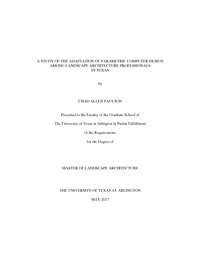| dc.description.abstract | Parametric design utilizes algorithmic-based software to produce computational, generative, responsive, and immersive three-dimensional models for use in landscape architecture, planning, and architecture (Cantrell & Holzman, 2016; Jabi, 2013). Advanced parametric software tools such as Rhinoceros and Grasshopper combine to create a robust system to express a set of customizable parameters that define and clarify the design intent and set of iterative solutions to a design problem (Jabi, 2013).
Although parametric design in architecture has been in use for over 15 years, it has not been broadly adopted by the field of landscape architecture. Current professional practices illustrate that software development within the design fields, including landscape architecture, are strongly trending towards augmented reality, open source software and building information modeling systems (Bentley, et al. 2016).
The purpose of this research is to understand the adaptation and implementation of the innovation of parametric design into the field of landscape architecture overall, then specifically to the practice and the speed with which the innovations are being adapted into landscape architecture firms in Texas. Research on this topic has the possibility to increase awareness of technological advancements in the practice and education of landscape architecture, architecture, and planning. In this study, the researcher documents the current understanding of parametric design in the practice of landscape architecture nationally and internationally through literature review, and then compares it to the practice in Texas by studying landscape architecture professionals’ perceptions on the issue.
This research followed qualitative methods (Deming & Swaffield, 2011) to acquire the knowledge needed to understand the adaptation and implementation of the innovation of parametric design in Texas. In this study, this researcher conducted in-depth interviews to discover patterns in the acceptance or likely adaptation of parametric design in landscape architecture firms. The subjects were designers or managers of landscape architect firms that practice landscape architecture in Texas. The snowball technique was used to acquire the study population (Taylor & Bogdan, 1998).
Rogers’ theory, Diffusion of Innovation, was used to design questions to be used while interviewing landscape architectural professionals to determine their level of adapting innovation (Rogers, 1995; Deming & Swaffield, 2011) to their design practices. Themes were drawn from the interviews using the Diffusion of Innovation categories, to document the overall rate of adaptation to the process of parametric design experienced from the participants in the interviews. The responses are studied qualitatively to understand where each firm or landscape professional stands within its process of innovation (Taylor & Bogdan, 1998; Deming & Swaffield, 2011).
In conclusion, this research assessed that adaptation is happening in landscape architecture firms in Texas, and summarizes its current usage and explores the technical, financial, and educational issues of adapting to these methods. The interviewees had a wide range of experience in professional management and practice. However, experience with emerging industry software and technology was more prevalent in the training of new staff then it is with upper management. Most firms agreed that technology changes are on the horizon, but there is no clear way of defining what that means for each practice using parametric design. | |

